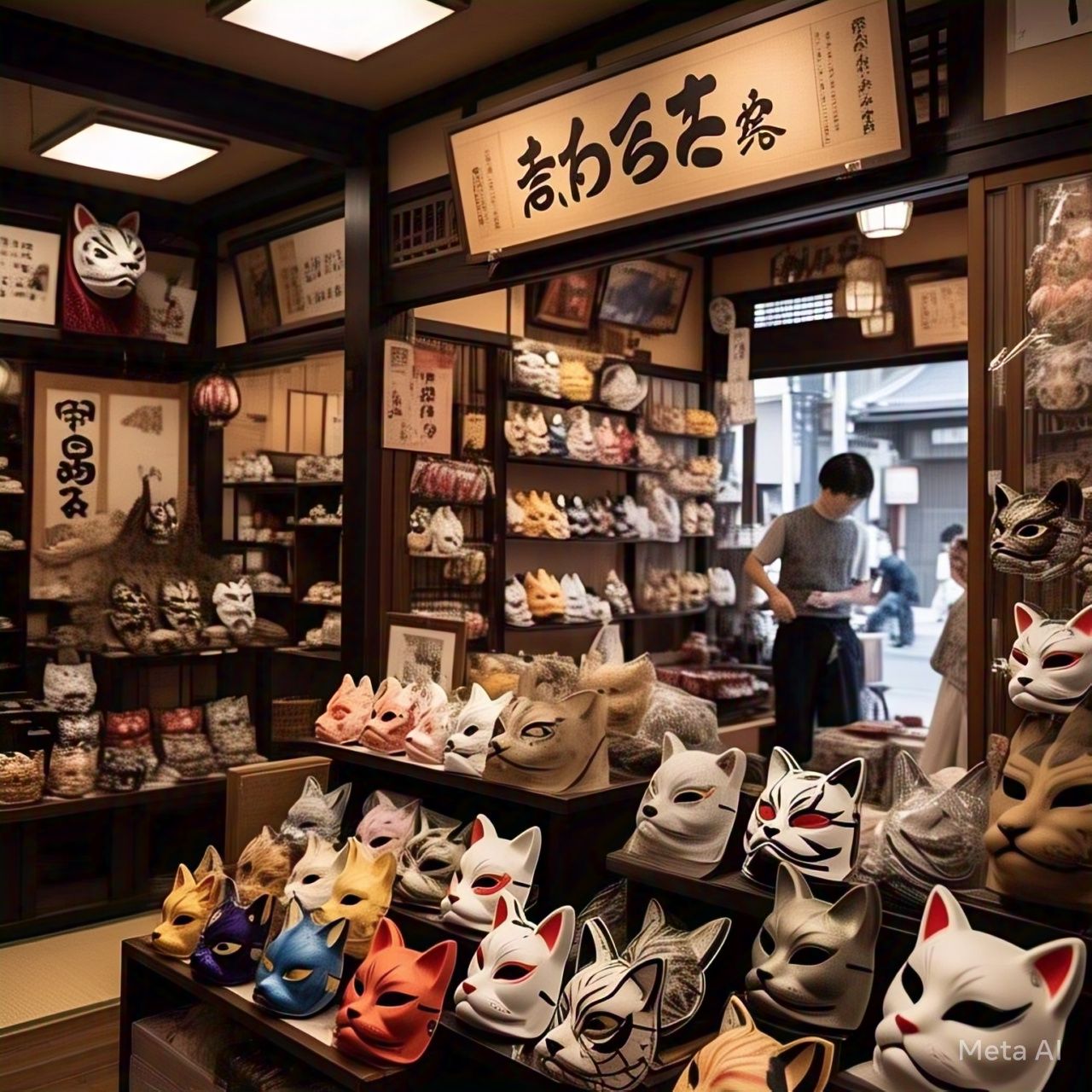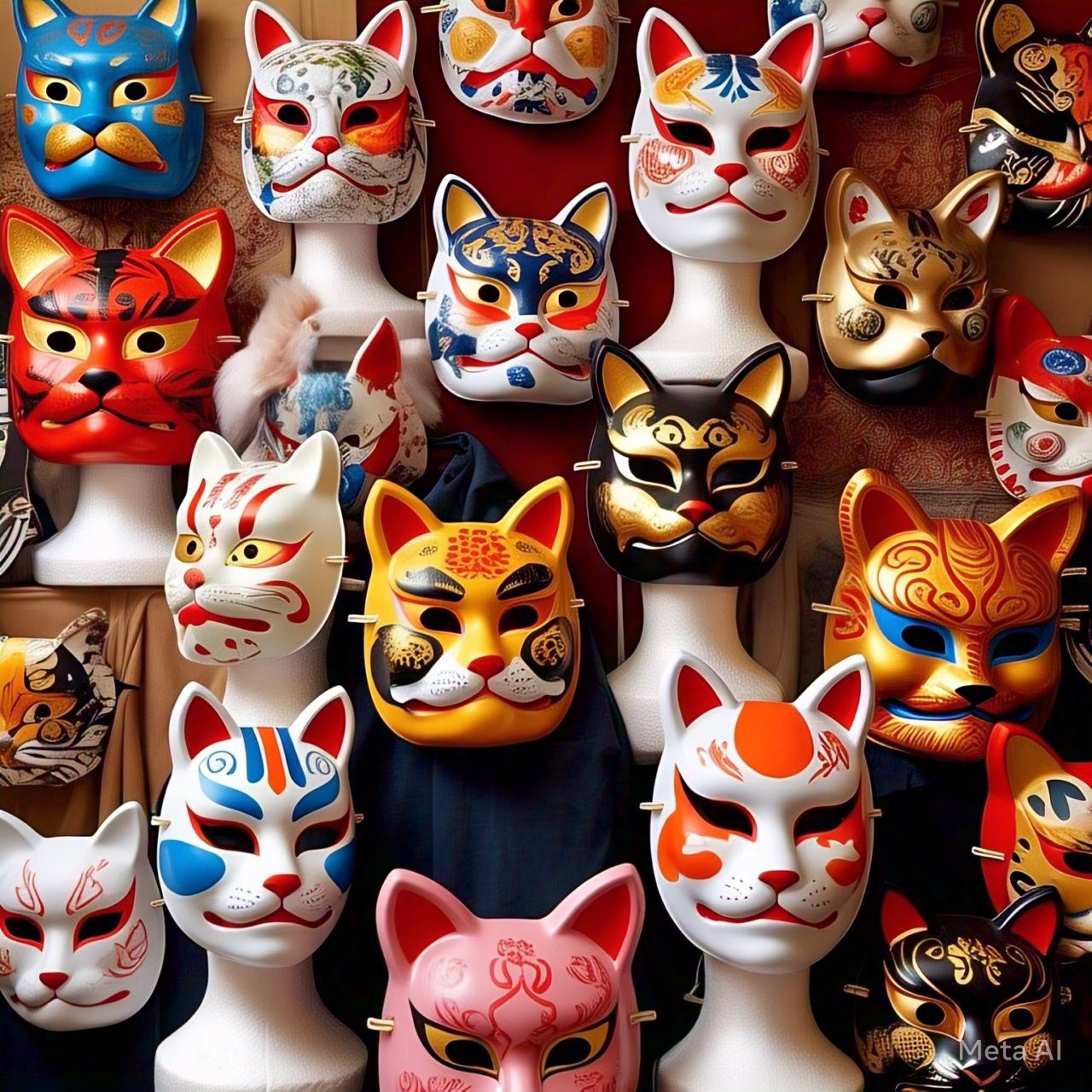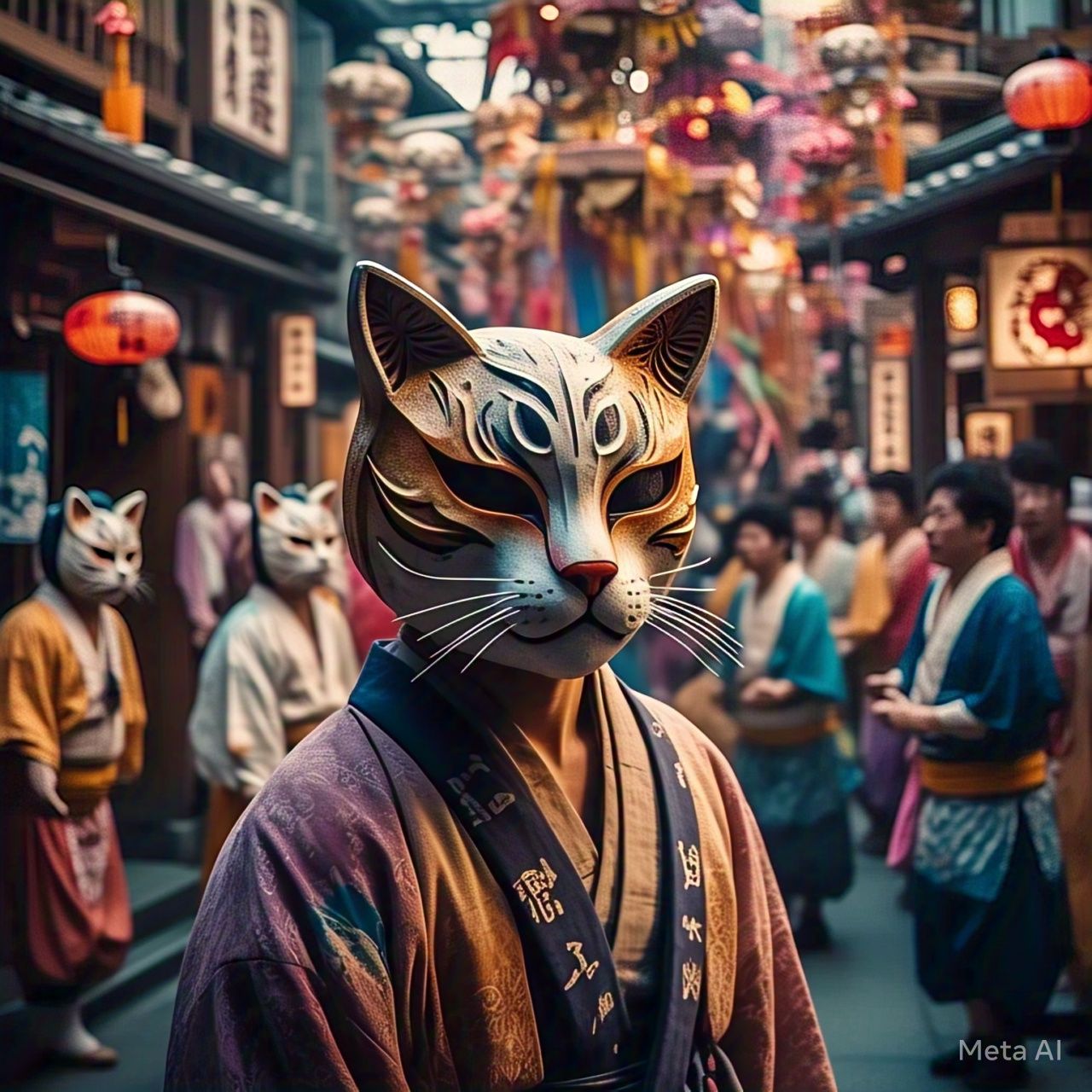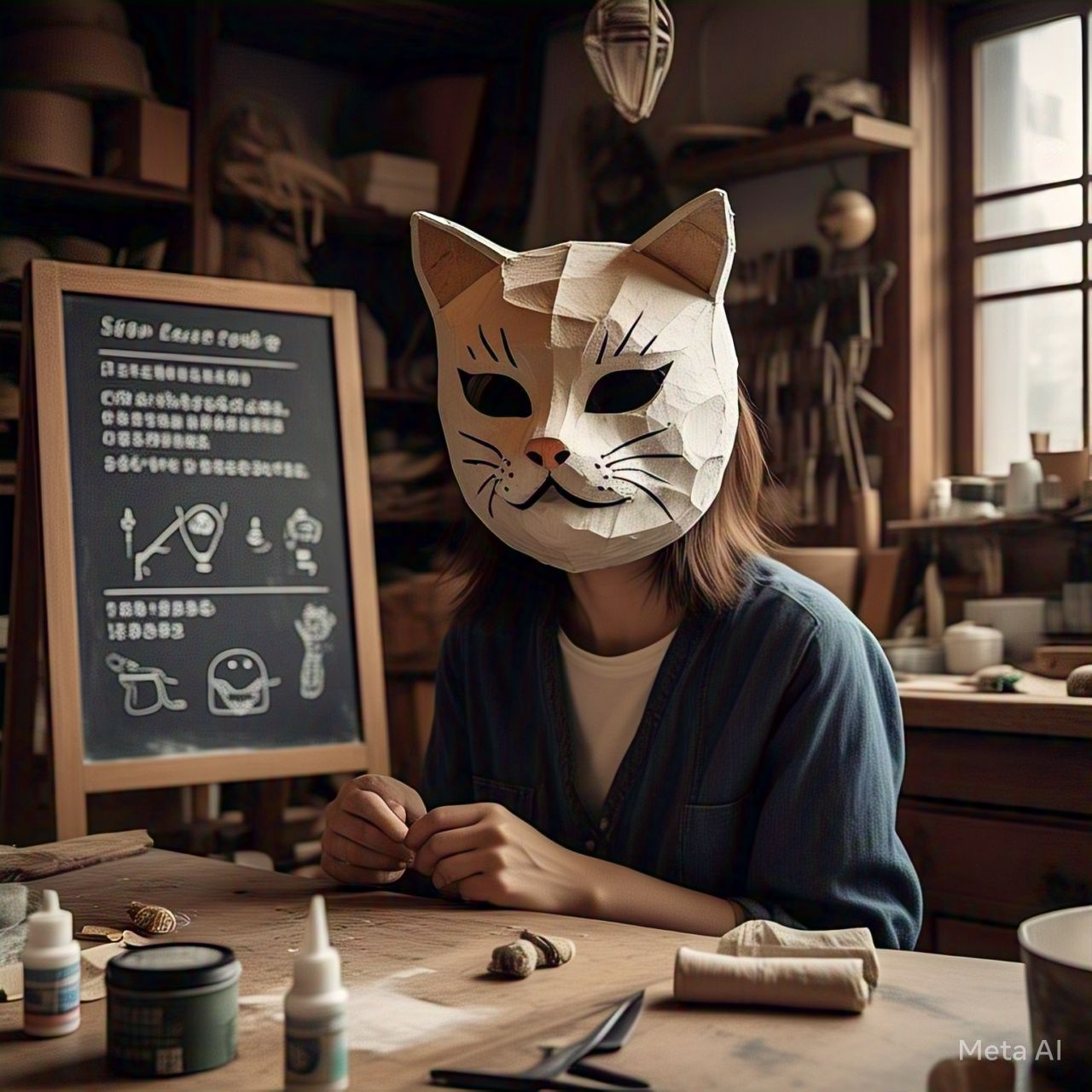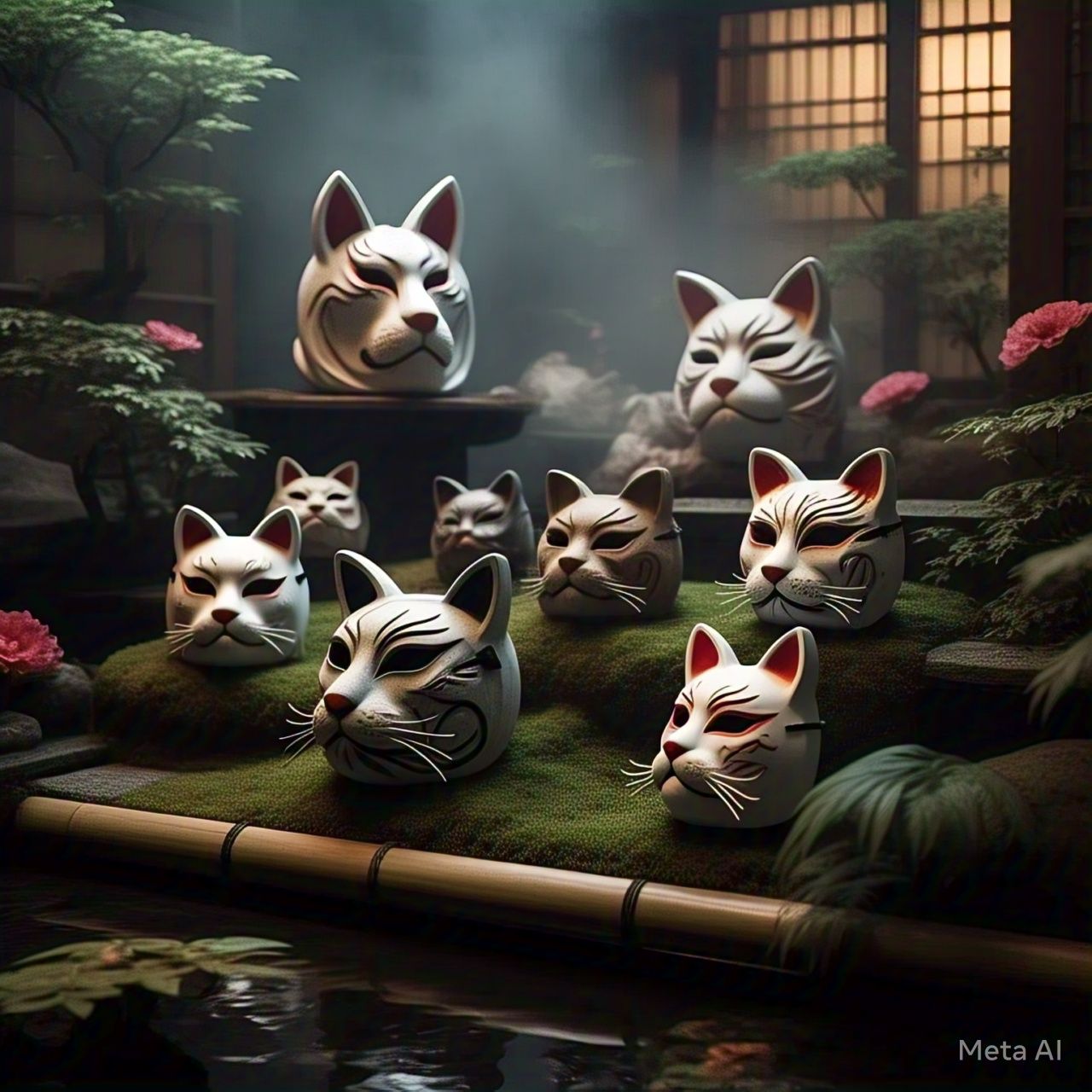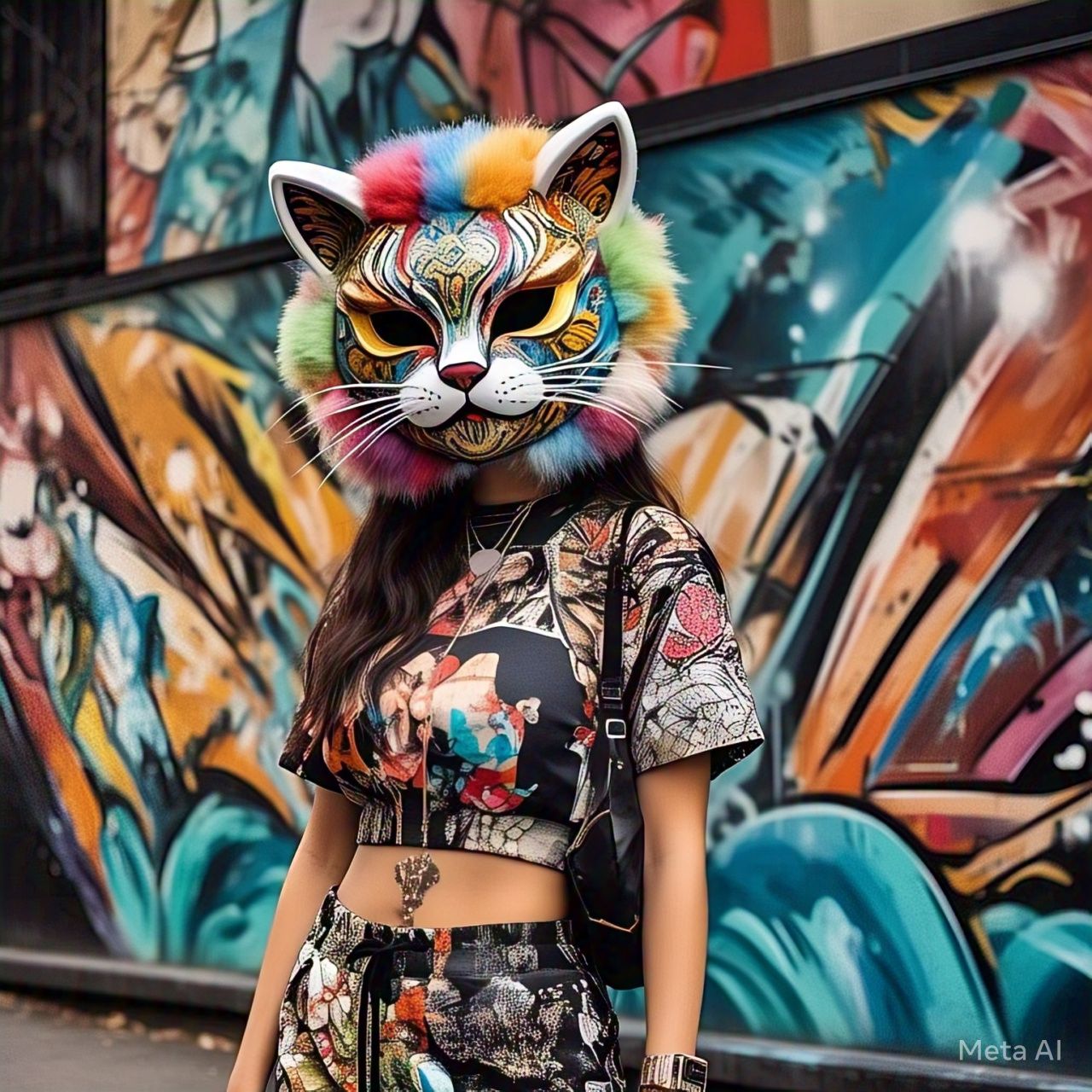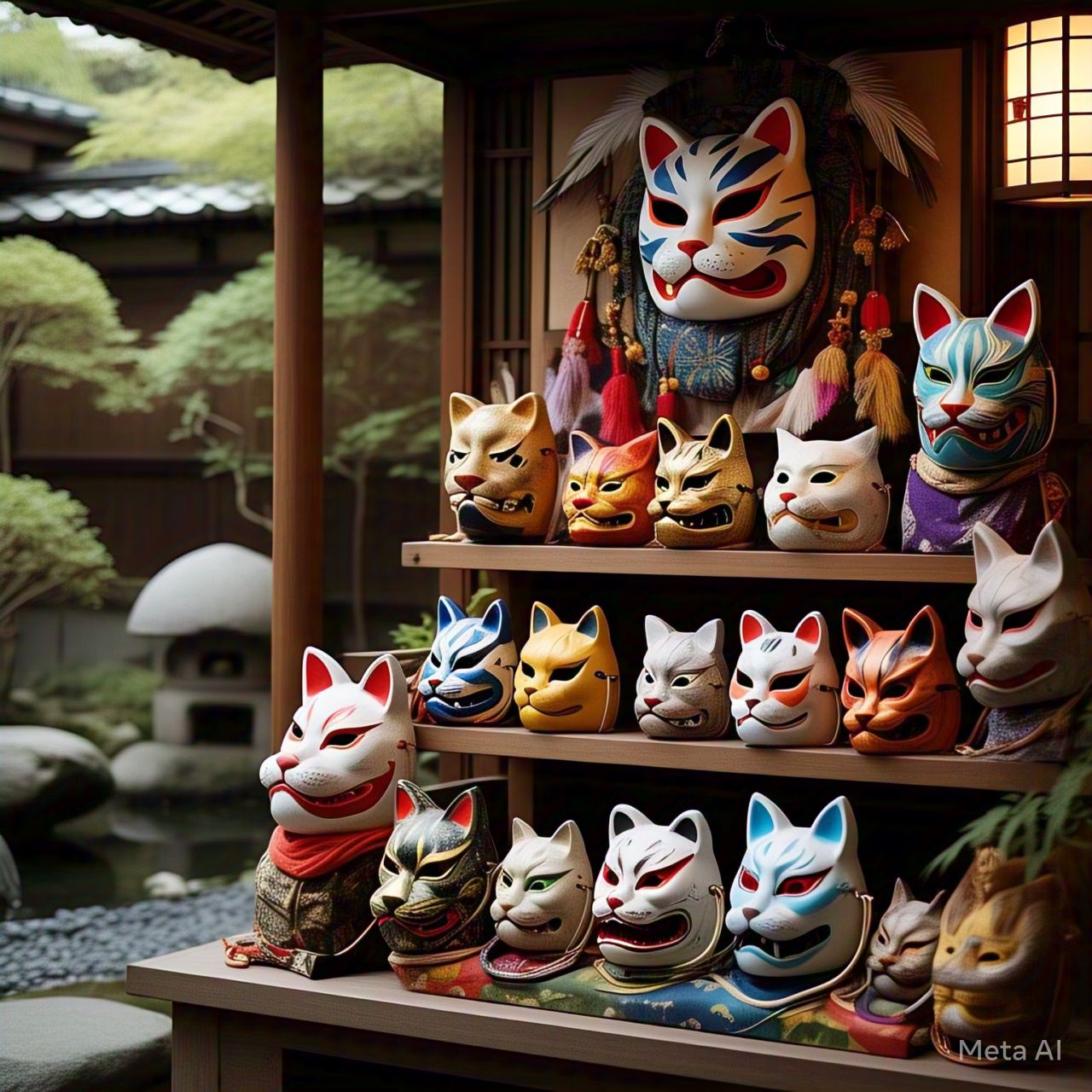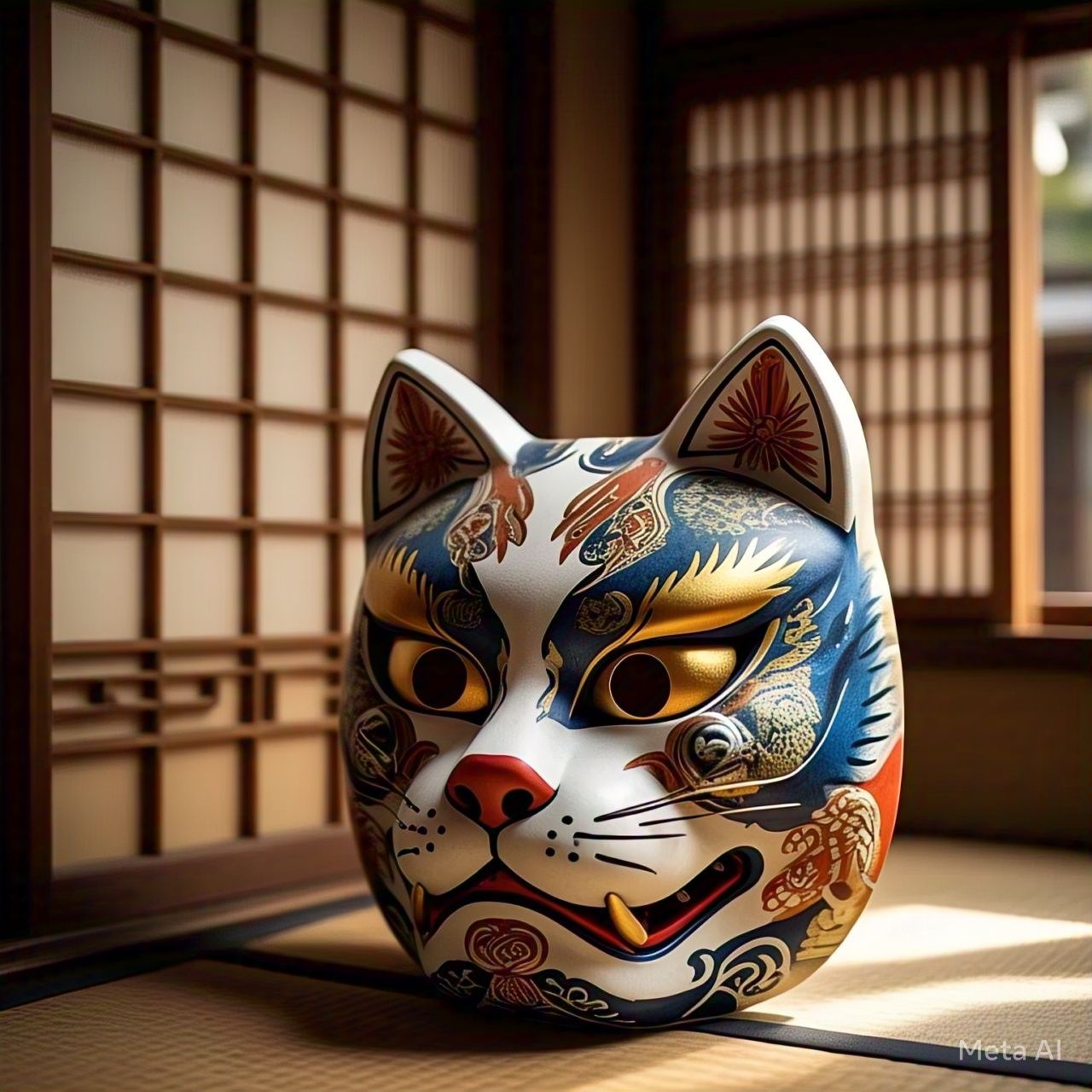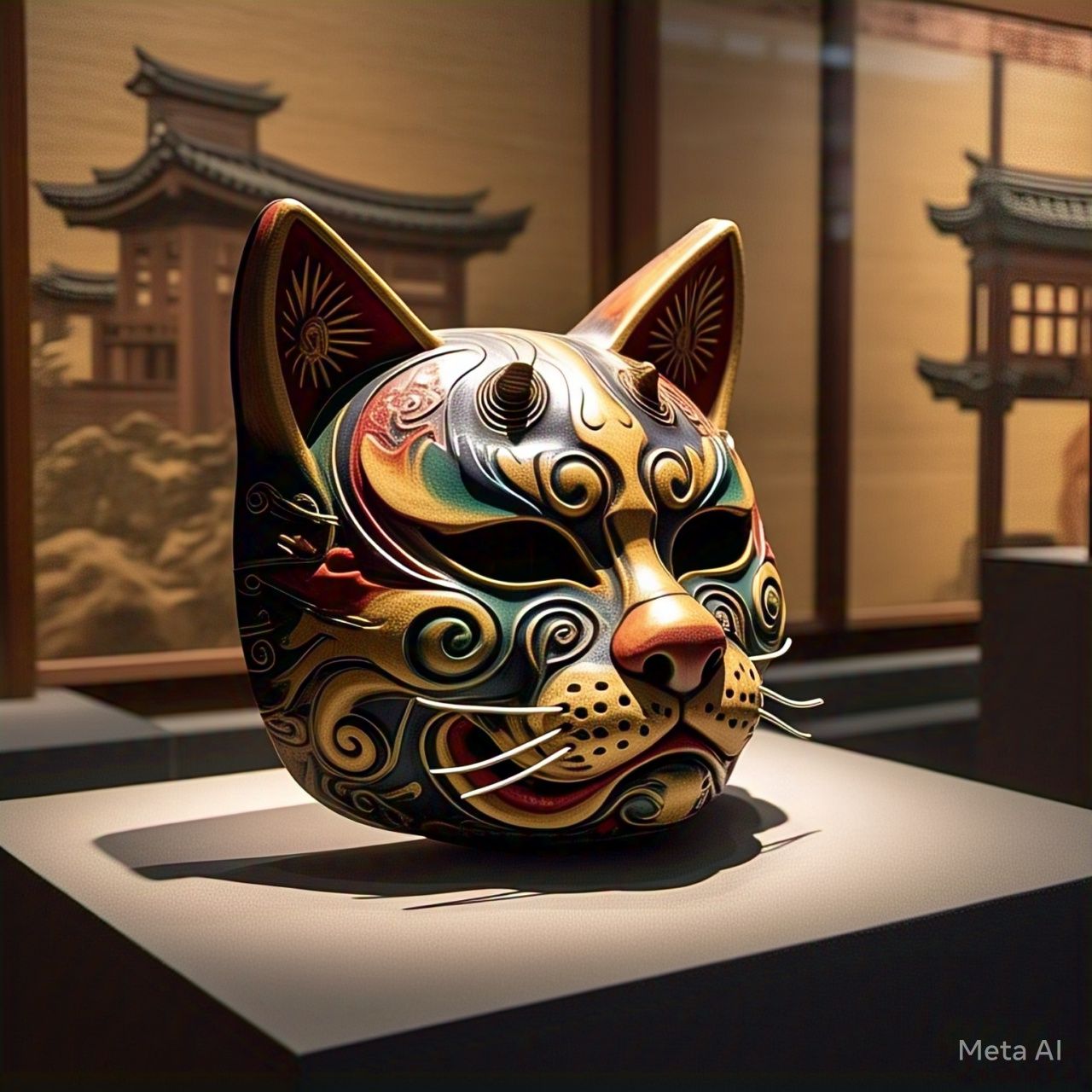Japanese cat masks, with their playful whiskers and expressive eyes, capture attention instantly. At first glance, they seem like charming accessories, perfect for festivals or social media selfies. Yet, their story runs far deeper than their cute appearance suggests. These masks carry centuries of tradition, woven into Japan’s spiritual and cultural fabric. From ancient rituals to modern celebrations, they reflect beliefs about cats as mystical creatures. This part explores the cultural roots of Japanese cat masks, uncovering their symbolic meaning and their role in connecting people to Japan’s heritage.
Cats hold a special place in Japanese folklore, often seen as more than ordinary animals. Tales of bakeneko, supernatural cats with shape-shifting abilities, have circulated for centuries. These stories portray cats as both protectors and tricksters, capable of bringing fortune or mischief. Masks inspired by these creatures emerged as a way to honor their dual nature. Artisans crafted them to capture the cat’s enigmatic spirit, blending reverence with creativity. In Shinto and Buddhist traditions, cats were sometimes linked to deities, believed to guard sacred spaces. Masks became a medium to channel this spiritual connection, worn during rituals to invite blessings or ward off evil.
The Maneki-neko, or beckoning cat, further shaped the imagery of cat masks. This iconic figure, often depicted with a raised paw, symbolizes prosperity and good luck. While not a mask itself, its influence appears in the wide-eyed, welcoming expressions of many designs. People began associating cat imagery with positive energy, making masks a popular choice for ceremonies. Over time, these masks transcended their religious origins, finding a place in community events and seasonal celebrations.
Festivals in Japan often blend the sacred with the joyful, and cat masks play a starring role in this mix. During events like the Nebuta Festival or local matsuri, performers don masks to embody characters from myth or history. Cat masks, with their versatile expressions, allow wearers to slip into roles ranging from playful spirits to wise guardians. The act of wearing a mask transforms the individual, creating a bridge between the human and the divine. Spectators, drawn to the masks’ charm, feel a shared connection to the stories being told.
In traditional theater, such as Noh and Kabuki, masks hold deep significance. While cat masks are less common in these formal arts, their influence appears in folk performances like kagura, where dancers mimic animals to honor nature. The cat’s agile movements and mysterious aura make it a fitting subject for such dances. Artisans design masks to enhance these performances, carving lightweight wood or shaping papier-mâché to allow fluid motion. Each mask tells a story, its details reflecting the character it represents.
Japan’s diverse regions add layers to the meaning of cat masks. In rural areas, where agriculture shaped daily life, cats were valued for protecting crops from pests. Masks honoring these animals became symbols of gratitude, worn during harvest festivals to thank the land. Coastal communities, meanwhile, linked cats to safety at sea, believing they could predict storms. Fishermen crafted masks with weathered textures, evoking the ocean’s unpredictability. These regional differences highlight how cat masks adapt to local beliefs, uniting communities through shared values.
Urban centers like Kyoto and Tokyo also embraced cat masks, though with a modern twist. In these cities, masks often blend traditional motifs with contemporary flair, appealing to younger generations. Artisans experiment with bold colors and abstract designs, preserving the mask’s cultural essence while making it accessible to new audiences. This evolution shows how cat masks remain relevant, bridging Japan’s past and present.
Beyond festivals and rituals, cat masks weave into daily life in subtle ways. In homes, small mask replicas decorate walls, serving as talismans for protection and luck. Craftsmen sell these at markets, where buyers choose designs that resonate with their personal hopes. A mask with a mischievous grin might appeal to someone seeking joy, while a serene expression could attract those craving calm. This personal connection makes cat masks more than decorative—they become part of people’s stories.
Shops and cafes in tourist areas often display cat masks to draw visitors, tapping into their universal appeal. Travelers, enchanted by the masks’ charm, buy them as souvenirs, carrying a piece of Japan’s culture home. Yet, even in these commercial spaces, the masks retain their symbolic weight. They remind people of the balance between playfulness and reverence that defines Japan’s view of cats.
Historical Evolution of Japanese Cat Masks
The charm of Japanese cat masks lies not only in their whimsical design but also in their rich historical journey. These masks have evolved over centuries, shaped by Japan’s shifting eras, from feudal times to the modern day. Each period left its mark, influencing materials, styles, and purposes. What began as ritual objects grew into cultural icons, reflecting the nation’s changing values and artistic trends. This part traces the historical path of cat masks, revealing how they adapted to social, political, and technological shifts while retaining their symbolic core.
Early Beginnings in Ancient Japan
In ancient Japan, masks of all kinds held spiritual significance. Used in Shinto rituals and early Buddhist ceremonies, they allowed priests to commune with deities or spirits. Cat masks, though not as prominent as those depicting foxes or tengu, emerged in this context. Craftsmen carved them from wood, painting delicate features to mimic feline grace. These early masks were simple, designed for function over flair. Their purpose was to honor cats as guardians, believed to protect sacred spaces from misfortune.
As villages grew, so did the role of cats in daily life. Farmers revered them for keeping rodents at bay, and stories of their mystical powers spread. Masks began appearing in community rites, worn to celebrate harvests or appease spirits. Unlike the elaborate masks of the elite, these were crafted by local artisans, using materials like clay or bamboo. Their rough textures and earthy tones reflected the humility of rural life, grounding cat masks in the struggles and joys of ordinary people.
Influence of the Heian and Kamakura Periods
The Heian period, known for its artistic refinement, brought new sophistication to mask-making. Aristocrats, fascinated by cats’ elegance, kept them as pets, inspiring poets and painters. Cat masks from this era, though rare, show intricate details—flowing whiskers, almond-shaped eyes, and subtle smiles. Craftsmen experimented with lacquer and gold leaf, creating masks that shimmered in candlelit halls. These were less about ritual and more about aesthetic pleasure, worn during courtly dances to delight nobles.
The Kamakura period, with its warrior culture, shifted the tone. Cats took on fiercer symbolism, linked to samurai ideals of vigilance and agility. Masks reflected this change, with sharper angles and bold expressions. Artisans began using lighter materials, like papier-mâché, to make masks easier to wear in performances. Folk tales of bakeneko grew popular, and masks captured their mischievous or menacing traits. This era marked a turning point, as cat masks spread beyond temples into public celebrations.
Edo Period and the Rise of Urban Culture
The Edo period ushered in peace and prosperity, transforming Japan’s cultural landscape. Cities like Edo and Osaka buzzed with merchants, artisans, and entertainers, creating a vibrant market for cat masks. No longer just for rituals, masks became festival staples, worn during parades and street performances. Craftsmen embraced bright colors—reds, blues, and golds—to catch the eye of urban crowds. Designs grew playful, with exaggerated features like oversized eyes or curled lips, reflecting the era’s love for spectacle.
Theater flourished, and cat masks found a niche in folk plays. Performers used them to portray spirits or comic characters, delighting audiences with their expressive range. Artisans competed to create standout designs, incorporating motifs from ukiyo-e prints, such as cherry blossoms or waves. The rise of the Maneki-neko during this period also influenced masks, with many adopting its cheerful, beckoning pose. Cat masks became symbols of good fortune, sold at shrines and markets to eager buyers.
Meiji Era and Western Influence
The Meiji era brought Japan into contact with the West, reshaping its traditions. Industrialization introduced new tools and materials, like molded plaster, allowing mass production of masks. Cat masks became more affordable, reaching a wider audience. At the same time, Western fascination with Japanese culture fueled demand for exotic souvenirs. Artisans responded with hybrid designs, blending traditional cat motifs with Victorian-inspired flourishes, like lace-like patterns or softer pastels.
Yet, this era also sparked a renewed appreciation for Japan’s heritage. As modernization swept the nation, some feared traditional crafts would fade. Artisans preserved cat mask techniques, passing them down through apprenticeships. Festivals grew in scale, showcasing masks as emblems of national pride. The tension between old and new gave cat masks a dual role: they were both nostalgic keepsakes and symbols of Japan’s global identity.
Modern Era and Global Reach
In the 20th century, cat masks adapted to Japan’s rapid modernization. Post-World War II, they became tourist favorites, sold in gift shops alongside kimonos and fans. Artisans balanced tradition with innovation, using plastics and synthetic paints for durability. The rise of anime and manga brought fresh inspiration, with masks mimicking beloved characters like Hello Kitty. These contemporary designs retained the cat’s symbolic essence—luck, mystery, playfulness—while appealing to younger generations.
Globalization spread cat masks beyond Japan’s borders. International festivals, cosplay events, and online marketplaces introduced them to new audiences. Artisans now cater to diverse tastes, creating masks with minimalist lines for Western buyers or vibrant patterns for Asian markets. Despite their global reach, the masks’ roots remain distinctly Japanese, tied to centuries of storytelling and craftsmanship.
The history of Japanese cat masks mirrors Japan’s own transformation, from ancient rituals to global fame. Each era—whether the spiritual Heian, bustling Edo, or modern digital age—added depth to their story. Artisans, performers, and everyday people shaped their evolution, ensuring they remained relevant. Today, cat masks stand as more than accessories; they are living artifacts, carrying the weight of tradition into the future. The next part will explore their artistic craftsmanship, revealing the skill behind their enduring appeal.
Artistry and Craftsmanship of Japanese Cat Masks
A Japanese cat mask, with its delicate curves and vivid colors, is a work of art that captivates at first sight. Beyond its charm lies a world of craftsmanship, where skilled hands transform raw materials into cultural treasures. These masks are not mass-produced trinkets but the result of centuries-old techniques, passed down through generations. Each one tells a story of dedication, blending tradition with personal expression. This part dives into the artistry behind Japanese cat masks, exploring the materials, methods, and creative spirit that make them extraordinary.
Materials and Their Significance
The choice of materials in cat mask-making reflects both practicality and symbolism. Wood, prized for its durability, has long been a favorite. Artisans select cedar or cypress, valuing their fine grain and lightweight nature. These woods carry spiritual weight, often sourced from sacred groves, connecting the mask to nature. Over time, papier-mâché gained popularity for its versatility, allowing intricate shapes without heavy tools. This material, made from layered paper and glue, offers a smooth surface for painting, perfect for capturing feline features.
Clay and plaster, used in some regions, add distinct textures. Clay masks, common in rural areas, have an earthy feel, evoking the soil cats once guarded. Plaster, introduced during industrialization, enables sharper details, ideal for urban markets. Paints, whether natural pigments or modern acrylics, bring masks to life. Red symbolizes vitality, white purity, and gold prosperity—colors chosen to align with the cat’s cultural meanings. Every material serves a purpose, balancing form, function, and tradition.
Techniques of Creation
Crafting a cat mask demands patience and precision. The process begins with sketching, where artisans map out the cat’s expression. A playful grin or narrowed eyes sets the tone, guiding every step. For wooden masks, carvers use chisels to shape the block, working slowly to avoid cracks. Each stroke refines the form, from the slope of the nose to the flick of a whisker. Sanding follows, smoothing the surface until it feels like silk under the fingers.
Papier-mâché masks require a different approach. Artisans layer strips of paper over a mold, building thickness gradually. Once dry, the mask is removed and reinforced, ensuring it withstands wear. This method allows flexibility—curved ears or raised cheeks emerge effortlessly. Painting is the final act, where artisans apply base coats, then add details like stripes or spots. Some use brushes as fine as a single hair to mimic fur patterns. Lacquer seals the design, giving it a glossy sheen that catches the light.
Role of Artisans
Artisans are the heart of cat mask-making, their skills honed over decades. Many train under masters, learning not just technique but philosophy. They view their work as a dialogue with tradition, respecting ancestors while adding personal touches. A master in Kyoto might carve masks with serene expressions, reflecting the city’s calm temples. In contrast, a Tokyo artisan could favor bold lines, echoing the capital’s energy. This individuality ensures no two masks are identical, each bearing the maker’s spirit.
Apprenticeships remain vital, though modern life challenges their survival. Young artisans balance tradition with economic pressures, often selling online to reach global buyers. Despite these shifts, the craft retains its rigor. Artisans spend years mastering tools, studying cat anatomy to capture their essence. They also learn to read clients, tailoring masks for festivals, theaters, or collectors. Their ability to adapt keeps the tradition alive, even as tastes evolve.
Regional Styles and Variations
Japan’s regions shape cat mask artistry in unique ways. In Tohoku, masks often feature rugged textures, reflecting the area’s harsh winters. Artisans here use dark paints to evoke resilience, with cats appearing watchful and strong. Kyushu, known for its vibrant festivals, favors brighter colors and exaggerated features. Masks from this region burst with energy, designed to stand out in crowded parades. These differences highlight how geography influences creativity, tying masks to local identities.
Urban artisans, meanwhile, blend old and new. In Osaka, masks might incorporate neon hues, inspired by the city’s nightlife. Tokyo craftsmen experiment with minimalist designs, appealing to cosmopolitan tastes. Yet, even these modern creations nod to tradition—subtle curves or symbolic colors preserve the mask’s roots. This balance of innovation and heritage makes cat masks a living art form, evolving without losing their soul.
Cultural Impact of Craftsmanship
The artistry of cat masks extends beyond their creation, shaping Japan’s cultural landscape. Museums display them alongside pottery and textiles, recognizing their value as heritage. Collectors seek rare pieces, valuing the maker’s reputation as much as the mask itself. In communities, mask-making workshops foster pride, teaching youth to appreciate their traditions. These efforts ensure the craft endures, even in a digital age.
Cat masks also inspire other arts. Painters and sculptors draw from their designs, while filmmakers use them to evoke mystery or nostalgia. Their influence reaches fashion, with designers creating clothing that mimics the masks’ patterns. This ripple effect shows how craftsmanship transcends its medium, touching lives in unexpected ways. A single mask, hung in a home or worn in a festival, carries the weight of this creative legacy.
The artistry of Japanese cat masks reveals a world of skill, tradition, and imagination. From the choice of wood to the stroke of a brush, every step reflects centuries of expertise. Artisans, whether in rural workshops or urban studios, keep this craft alive, adapting to new eras while honoring the past. Their work transforms cat masks into more than accessories—they are symbols of Japan’s creative spirit. The next part will explore their modern relevance, showing how they thrive in today’s global culture.
Modern Relevance of Japanese Cat Masks
In today’s fast-paced world, Japanese cat masks remain a vibrant link to tradition, yet they also shine in new contexts. No longer confined to festivals or shrines, they appear in fashion, pop culture, and digital spaces, captivating global audiences. Their playful designs and deep symbolism resonate with people seeking both fun and meaning. This part examines the modern relevance of cat masks, exploring how they bridge Japan’s heritage with contemporary trends, from social media to international markets.
Pop Culture and Media Influence
Japan’s pop culture has propelled cat masks into the spotlight. Anime and manga, with their love for feline characters, inspire mask designs that echo iconic figures like Jiji from Kiki’s Delivery Service. These masks, with sleek lines and bold expressions, appeal to fans who see cats as symbols of independence and charm. Cosplay events, where enthusiasts dress as favorite characters, feature cat masks as key accessories, blending traditional craftsmanship with modern fandom.
Television and film also amplify their reach. Dramas set in historical Japan often showcase masks during festival scenes, sparking curiosity among viewers. Reality shows exploring crafts highlight artisans at work, revealing the effort behind each mask. This exposure educates audiences, turning casual interest into appreciation. Even video games, like those set in mythical Japan, incorporate cat masks as collectibles, embedding them in virtual worlds where players connect with their symbolism.
Fashion and Street Style
Cat masks have found a home in Japan’s vibrant fashion scene. Designers draw inspiration from their shapes and colors, creating clothing and accessories that capture their spirit. A scarf might feature whisker-like patterns, or a handbag could mimic a mask’s curved eyes. Street style in Harajuku and Shibuya embraces this trend, with youth pairing masks with eclectic outfits. Worn as statement pieces, masks add a playful edge, blending tradition with rebellion.
High fashion also takes note. Runways in Tokyo showcase masks alongside kimonos, reimagining them as avant-garde art. International brands, intrigued by Japan’s aesthetic, collaborate with artisans to produce limited-edition masks. These pieces, often sold at premium prices, attract collectors who value their cultural weight. By merging old-world craft with modern flair, cat masks redefine what it means to be stylish.
Social Media and Global Appeal
The rise of social media has turned cat masks into global sensations. Platforms like Instagram and TikTok brim with photos and videos of people wearing them, often at festivals or cosplay events. Influencers showcase masks to millions, highlighting their versatility—cute for one post, mystical for another. Hashtags tied to Japanese culture trend regularly, drawing users to explore the masks’ origins. This digital stage amplifies their charm, making them accessible to anyone with a smartphone.
Online marketplaces like Etsy and Amazon further their reach. Artisans sell directly to buyers in Europe, America, and beyond, offering everything from handmade replicas to affordable prints. Customers leave reviews praising the masks’ craftsmanship, spreading word-of-mouth buzz. Virtual communities, like forums for Japan enthusiasts, discuss their symbolism, fostering a shared love for the tradition. Through these platforms, cat masks transcend borders, becoming global symbols of creativity.
Role in Tourism and Festivals
Tourism keeps cat masks thriving in Japan. Visitors flock to cities like Kyoto, eager to experience authentic culture. Shops in tourist districts display masks alongside lanterns and fans, inviting travelers to take home a piece of Japan. Guided tours of artisan workshops reveal the craft’s complexity, leaving guests in awe. Many buy masks as souvenirs, not just for their beauty but for the stories they carry—tales of luck, protection, and joy.
Festivals remain a key stage for cat masks. Events like the Aomori Nebuta or Fukuoka’s Hakata Gion Yamakasa draw crowds, with performers wearing masks to embody local legends. Tourists, enchanted by the spectacle, often join in, donning masks bought on-site. These moments create lasting memories, tying the masks to Japan’s living traditions. Even smaller, rural festivals maintain this spirit, ensuring the masks’ relevance in every corner of the country.
Future of Cat Masks
The future of cat masks looks bright, fueled by innovation and nostalgia. Artisans experiment with eco-friendly materials, like recycled paper or plant-based dyes, aligning with global sustainability trends. Technology, such as 3D printing, offers new ways to craft intricate designs, though purists still favor handwork. Younger generations, raised on anime and social media, embrace masks as both heritage and self-expression, ensuring their appeal endures.
Challenges exist, like preserving authenticity amid commercialization. Mass-produced masks, sold cheaply, sometimes lack the soul of handmade ones. Yet, artisans counter this by emphasizing quality, hosting exhibitions to showcase their craft. Schools and cultural programs teach mask-making to youth, passing down skills. These efforts suggest cat masks will evolve without losing their essence, remaining cherished for generations.
Japanese cat masks thrive in the modern world, their charm undimmed by time. From pop culture to fashion, social media to festivals, they adapt effortlessly, blending tradition with today’s trends. Their global reach reflects a universal love for cats, yet their roots stay firmly Japanese, tied to stories of luck and mystery. As artisans innovate and communities celebrate, cat masks prove they are more than accessories—they are timeless symbols of culture and creativity.
